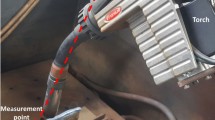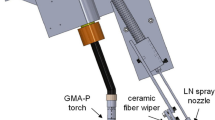Abstract
This work aimed at introducing and exploring the potential of a thermal management technique, named as near-immersion active cooling (NIAC), to mitigate heat accumulation in Wire + Arc Additive Manufacturing (WAAM). According to this technique concept, the preform is deposited inside a work tank that is filled with water, whose level rises while the metal layers are deposited. For validation of the NIAC technique, Al5Mg single-pass multi-layer linear walls were deposited by the CMT® process under different thermal management approaches. During depositions, the temperature history of the preforms was measured. Porosity was assessed as a means of analyzing the potential negative effect of the water cooling in the NIAC technique. The preform geometry and mechanical properties were also assessed. The results showed that the NIAC technique was efficient to mitigate heat accumulation in WAAM of aluminum. The temperature of the preforms was kept low independently of its height. There was no measurable increase in porosity with the water cooling. In addition, the wall width was virtually constant, and the anisotropy of mechanical properties tends to be reduced, characterizing a preform quality improvement. Thus, the NIAC technique offers an efficient and low-cost thermal management approach to mitigate heat accumulation in WAAM and, consequently, also to cope with the deleterious issues related to such emerging alternative of additive manufacturing.












Similar content being viewed by others
References
Herzog D, Seyda V, Wycisk E, Emmelmann C (2016) Additive manufacturing of metals. Acta Mater 117:371–392. https://doi.org/10.1016/j.actamat.2016.07.019
Debroy T, Wei HL, Zuback JS et al (2018) Progress in materials science additive manufacturing of metallic components – process, structure and properties. Prog Mater Sci 92:112–224. https://doi.org/10.1016/j.pmatsci.2017.10.001
Williams SW, Martina F, Addison AC et al (2016) Wire + arc additive manufacturing. Mater Sci Technol 32:641–647. https://doi.org/10.1179/1743284715Y.0000000073
Ding D, Pan Z, Cuiuri D, Li H (2015) Wire-feed additive manufacturing of metal components: technologies, developments and future interests. Int J Adv Manuf Technol 81:465–481. https://doi.org/10.1007/s00170-015-7077-3
ASTM (2016) ASTM F3187 - 16 - standard guide for directed energy deposition of metals. ASTM Int:1–22. https://doi.org/10.1520/F3187
Yang D, Wang G, Zhang G (2017) Thermal analysis for single-pass multi-layer GMAW based additive manufacturing using infrared thermography. J Mater Process Technol 244:215–224. https://doi.org/10.1016/j.jmatprotec.2017.01.024
Wu B, Pan Z, Ding D et al (2018) The effects of forced interpass cooling on the material properties of wire arc additively manufactured Ti6Al4V alloy. J Mater Process Technol 258:97–105. https://doi.org/10.1016/j.jmatprotec.2018.03.024
Manvatkar V, De A, Debroy T (2014) Heat transfer and material flow during laser assisted multi-layer additive manufacturing. J Appl Phys 116:1–8. https://doi.org/10.1063/1.4896751
Wang JF, Sun QJ, Wang H et al (2016) Effect of location on microstructure and mechanical properties of additive layer manufactured Inconel 625 using gas tungsten arc welding. Mater Sci Eng A 676:395–405. https://doi.org/10.1016/j.msea.2016.09.015
Foster BK, Beese AM, Keist JS, McHale ET, Palmer TA (2017) Impact of interlayer dwell time on microstructure and mechanical properties of nickel and titanium alloys. Metall Mater Trans A Phys Metall Mater Sci 48:4411–4422. https://doi.org/10.1007/s11661-017-4164-0
Xiong J, Lei Y, Chen H, Zhang G (2017) Fabrication of inclined thin-walled parts in multi-layer single-pass GMAW-based additive manufacturing with flat position deposition. J Mater Process Technol 240:397–403. https://doi.org/10.1016/j.jmatprotec.2016.10.019
Wu B, Ding D, Pan Z et al (2017) Effects of heat accumulation on the arc characteristics and metal transfer behavior in wire arc additive manufacturing of Ti6Al4V. J Mater Process Technol 250:304–312. https://doi.org/10.1016/j.jmatprotec.2017.07.037
Xu X, Ding J, Ganguly S et al (2018) Oxide accumulation effects on wire + arc layer-by-layer additive manufacture process. J Mater Process Technol 252:739–750. https://doi.org/10.1016/j.jmatprotec.2017.10.030
Lei Y, Xiong J, Li R (2018) Effect of inter layer idle time on thermal behavior for multi-layer single-pass thin-walled parts in GMAW-based additive manufacturing. Int J Adv Manuf Technol 96:1355–1365. https://doi.org/10.1007/s00170-018-1699-1
Denlinger ER, Heigel JC, Michaleris P, Palmer TA (2015) Effect of inter-layer dwell time on distortion and residual stress in additive manufacturing of titanium and nickel alloys. J Mater Process Technol 215:123–131. https://doi.org/10.1016/j.jmatprotec.2014.07.030
Lu X, Zhou YF, Xing XL, Shao LY, Yang QX, Gao SY (2017) Open-source wire and arc additive manufacturing system: formability, microstructures, and mechanical properties. Int J Adv Manuf Technol 93:2145–2154. https://doi.org/10.1007/s00170-017-0636-z
Henckell P, Günther K, Ali Y et al (2017) The in fl uence of gas cooling in context of wire arc additive manufacturing - a novel strategy of affecting grain structure and size. TMS Miner:147–156. https://doi.org/10.1007/978-3-319-51493-2
Wang H, Jiang W, Ouyang J, Kovacevic R (2004) Rapid prototyping of 4043 Al-alloy parts by VP-GTAW. J Mater Process Technol 148:93–102. https://doi.org/10.1016/j.jmatprotec.2004.01.058
Xiong J, Zhang G (2014) Adaptive control of deposited height in GMAW-based layer additive manufacturing. J Mater Process Technol 214:962–968. https://doi.org/10.1016/j.jmatprotec.2013.11.014
Li F (2018) Thermoelectric cooling-aided bead geometry regulation in wire and arc-based additive manufacturing of thin-walled structures. Appl Sci 8:207. https://doi.org/10.3390/app8020207
Reis RP, Scotti A, da Silva LJ (2018) Active Cooling Technique for Additive Manufacturing. 1–50
Haselhuhn AS, Buhr MW, Wijnen B et al (2016) Materials science & engineering a structure-property relationships of common aluminum weld alloys utilized as feedstock for GMAW-based 3-D metal printing. Mater Sci Eng A 673:511–523. https://doi.org/10.1016/j.msea.2016.07.099
Ryan EM, Sabin TJ, Watts JF, Whiting MJ (2018) The in fl uence of build parameters and wire batch on porosity of wire and arc additive manufactured aluminium alloy 2319. J Mater Process Tech 262:577–584. https://doi.org/10.1016/j.jmatprotec.2018.07.030
Toda H, Hidaka T, Kobayashi M et al (2009) Growth behavior of hydrogen micropores in aluminum alloys during high-temperature exposure. Acta Mater 57:2277–2290. https://doi.org/10.1016/j.actamat.2009.01.026
Gu J, Ding J, Williams SW et al (2016) The effect of inter-layer cold working and post-deposition heat treatment on porosity in additively manufactured aluminum alloys. J Mater Process Technol 230:26–34. https://doi.org/10.1016/j.jmatprotec.2015.11.006
Horgar A, Fostervoll H, Nyhus B et al (2018) Additive manufacturing using WAAM with AA5183 wire. J Mater Process Tech 259:68–74. https://doi.org/10.1016/j.jmatprotec.2018.04.014
Zhang C, Li Y, Gao M, Zeng X (2018) Wire arc additive manufacturing of Al-6Mg alloy using variable polarity cold metal transfer arc as power source. Mater Sci Eng A 711:415–423. https://doi.org/10.1016/j.msea.2017.11.084
Acknowledgments
The authors acknowledge the Center for Research and Development of Welding Processes (Laprosolda) at Federal University of Uberlândia for the laboratorial infrastructure. The authors also thank Fronius International Gmbh, particularly Stephan Egerland, Ph.D, for kindly providing the CMT equipment used.
Funding
This study was supported by the Brazilian Coordination for the Improvement of Higher Education Personnel (CAPES), through Finance Code 001, and by the Brazilian National Council for Scientific and Technological Development (CNPq), through grants 302863/2016-8 and 315092/2018-1.
Author information
Authors and Affiliations
Corresponding author
Additional information
Publisher’s note
Springer Nature remains neutral with regard to jurisdictional claims in published maps and institutional affiliations.
Rights and permissions
About this article
Cite this article
da Silva, L.J., Souza, D.M., de Araújo, D.B. et al. Concept and validation of an active cooling technique to mitigate heat accumulation in WAAM. Int J Adv Manuf Technol 107, 2513–2523 (2020). https://doi.org/10.1007/s00170-020-05201-4
Received:
Accepted:
Published:
Issue Date:
DOI: https://doi.org/10.1007/s00170-020-05201-4




